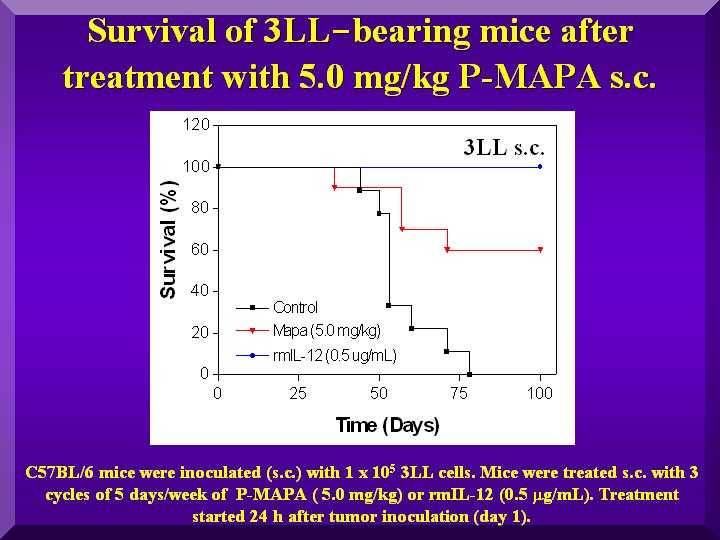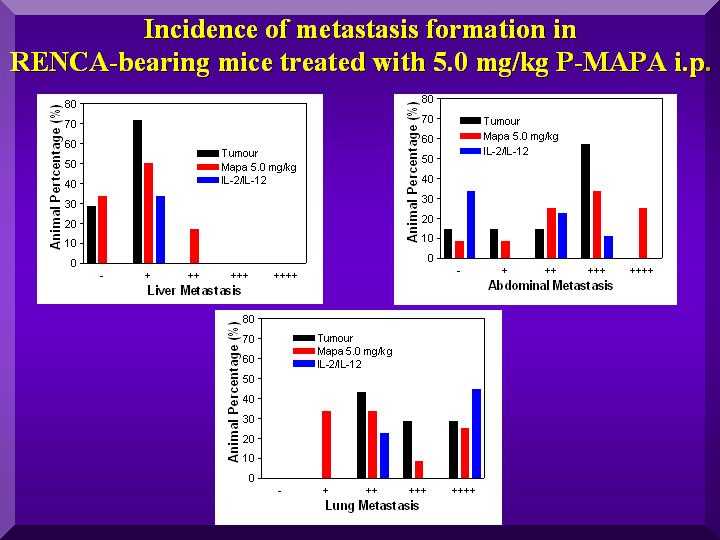

 Home |
Site Map |
Add to Favorites Link |
Send page to a Friend |
Contact us
Home |
Site Map |
Add to Favorites Link |
Send page to a Friend |
Contact us

|

 Home |
Site Map |
Add to Favorites Link |
Send page to a Friend |
Contact us
Home |
Site Map |
Add to Favorites Link |
Send page to a Friend |
Contact us
|
| About Us | Products | Research and Development | Publications and Press | Clinical Trials | Latest News | Contact us |
 |

10/07/2008
• Effect of P-MAPA on Lewis lung carcinoma
Lewis carcinoma tumor (LLC): LLC is a cell line established from the lung of a C57BL mouse bearing a tumour resulting from the implantation of primary Lewis lung carcinoma. The cell line is highly tumorigenic and an important tumor model in studies of metastasis development. To date, the only reproducible syngeneic model for lung cancer is the Lewis lung carcinoma (LLC) model. In addition, syngeneic murine models prove to be a valuable in predicting clinical benefit of therapy in preclinical experiments (Kellar A. et al, 2015)
Experimental design: 30 C57BL/6 mice inoculated with 1x105 cells of Lewis Lung carcinoma (LLC) per mouse.
After 24 h of the tumor inoculation, mice were treated with 3 weekly cycles of 5 mg/kg P-MAPA (n=10).
Positive controls (n=10) received IL-12 (0,5 ug/kg) for the same period of time.
Negative controls (n=10) received only saline
Treatments started 24 hours after tumour inoculation. All groups were checked daily for survival for 100 days.
RESULTS
P-MAPA: A 60% of survival at 100 days of observation was found in the animal group treated with 5.0 mg/kg of P-MAPA relative to controls (Figure 1).
The result is statistically significant (p=0.005) with regard to the negative control group. All of the negative control animals (n=10) died within 78 days (Figure 1)
IL-12: A 100% of survival at 100 days of observation was found in the group treated with 0,5 ug/ml of IL-12 at 100 days of observation (FIgure 1).
Figure 1

COMENTS
Comparatively, IL-12 shows 100% of survivals. Tough presenting small efficacy, the very low toxicity of P-MAPA over IL-12 may be advantageous in a future use of P-MAPA for treatment for localized or metastatic lung cancer.
It may be interesting to note that animals of the group treated with 5.0 mg/kg of P-MAPA in the experiment with the murine renal carcinoma (RENCA) also had higher survival rate and lower number of lung metastases than the negative control group (Figure 2).
Figure 2

Conclusions
• The positive results achieved with the use of P-MAPA on Lewis lung carcinoma (3LL) show a very significant action of the compound in this tumor model.
• These data indicate a great potential of the compound for the treatment or prevention of localized or metastatic lung tumors.


|